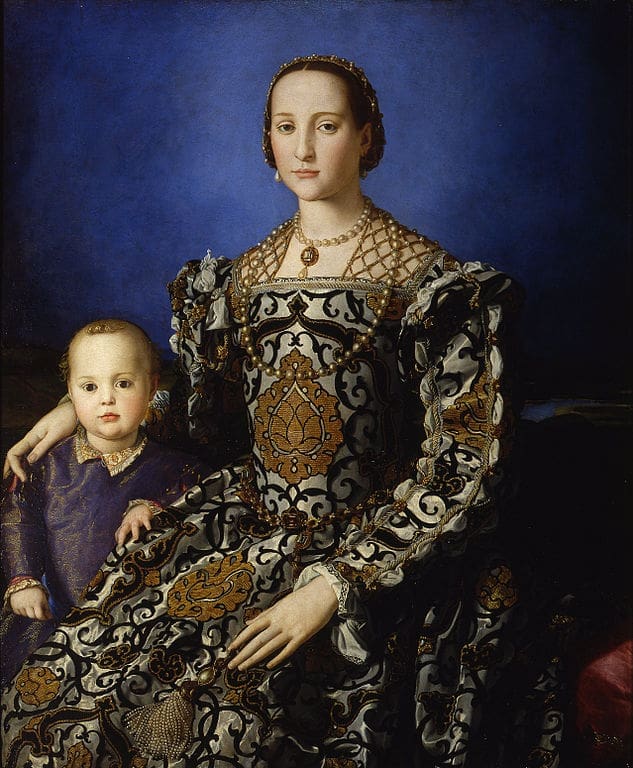
Facts about Italy
Official Name: Italian Republic
Form of Government: Republic
Capital: Rome
Population: 60, 606, 230
Official Language: Italian
Money: Euro
Area: 301,277 square kilometres
Major Mountain Ranges: Alps, Apennines
Major Rivers: Po, Adige, Arno, Tiber
Italy: geography and landscape
Italy is a boot-shaped peninsula that juts out of southern Europe into the Adriatic Sea, Tyrrhenian Sea, Mediterranean Sea and other waters. Its location has played an important role throughout its history.
The sea surrounds Italy, and mountains crisscross the interior, dividing the land into regions. The Alps cut across the top of the country and are streaked with long, thin glacial lakes. From the western end of the Alps, the Apennines mountains stretch south down the entire peninsula.
West of the Apennines are wooded hills that are home to many of Italy’s historic cities, including Rome. In the south are hot, dry coastlands and fertile plains where olives, almonds, figs and other crops are grown.
Italy’s beautiful nature
For 22 centuries, Italians and their ancestors have hunted wild animals, cleared fields and grazed livestock. As a result, forests that once covered large areas of the country are gone. But the country’s remote places still have wilderness largely untouched by humans. The lower slopes of Italy’s Alps remain covered with thick forests, and above these woodlands are meadows where specially adapted wildflowers bloom.
Amongst the amazing mammals found in Italy are the Eurasian lynx, Italian wolf, Roe deer and Etruscan shrew – the smallest land mammal in the world! Sadly, however, human activity and habitat loss has put much of Italy’s awesome animals under threat. To help protect them, National Parks have been set up, such as Abruzzo National Park – the only place in the world where the critically endangered Marsican brown bear can be found.
Throughout Italy, millions of beautiful birds stop to rest during their annual migration to Africa.
Italian history
Italy’s location on the Mediterranean linked it with the trade routes of the ancient civilisations that developed in the region. With the city of Rome’s rise to power, the Italian peninsula became the centre of a huge empire that lasted for centuries.
Italy’s first societies emerged around 1200 BC. Around 800 BC, Greeks settled in the south and a civilisation called the Etruscans arose in central Italy.
By the sixth century BC, the Etruscans had created a group of states called Etruria. Meanwhile, Latin and Sabine people south of Etruria merged to form a strong city-state called Rome.
Etruscan kings ruled Rome for nearly a hundred years. But the Romans kicked out the Etruscans in 510 BC and went on to conquer the whole peninsula. They then set out to build a vast empire which, at its greatest extent in AD 117, stretched from Portugal to Syria to Britain to North Africa. Pretty huge, eh?
The first sole emperor of Rome, Octavian, took power in 27 BC and took the name Augustus Caesar. The empire flourished for more than 400 years, but by the fourth century AD it was in decline. In 395, the empire was split in two, and in 476, Germanic tribes from the north toppled the last emperor.
In the 12th century, Italian city-states began to rise again and grow rich on trade. But Italy remained a patchwork of territories, some of which were controlled by foreign powers. Beginning in 1859, an uprising forced the foreigners out, and in 1861 the Kingdom of Italy was proclaimed.
In 1914, Italy took the side of the United Kingdom and the United States in World War I, but was left in poverty at war’s end. Benito Mussolini and his Fascist Party rose to power soon after, promising to restore Italy to its former glory. He ruled as a dictator and entered World War II on the side of Germany and Japan. In the final days of the war in 1945, Mussolini was captured and executed.
Italian people and culture
Throughout history, Italian art, architecture and culture have had an influence around the world. Famed Italian painters include Leonardo da Vinci and Michelangelo. Italy is also at the heart of the Catholic Church, which is governed from the Vatican City, a city-state surrounded by Rome.
The family is at the centre of Italian society. Young people often live at home until they are in their 30s, even if they have a job. When parents retire, they often go to live with their children.
Italians are also known for their love of food! Many Italian dishes have become popular worldwide, such as their famous pizza Margherita, spaghetti Bolognese and super-tasty tiramisu!
Government and economy
In Italy, politics can often be exciting and noisy. Crowds gather in the streets to protest government policies or to show support for their party.
Since World War II, Italy has enjoyed an economic transformation. Industry grew, and by the mid-1960s, Italy had become one of the world’s leading economies. Today, the country’s main exports include machinery, vehicles, pharmaceuticals, plastics and clothing. Tourism is also an important part of Italy’s economy, with millions of people visiting every year to enjoy the country’s famous cities, historical buildings and beautiful beaches!
Language and literature :
The native language of the Romans was Latin. Its alphabet was based on the Etruscan alphabet, which was in turn based on the Greek alphabet. The surviving Latin literature is in Classical Latin from the 1st century BC. The spoken language of the Roman Empire was Vulgar Latin, which differed from Classical Latin in grammar and vocabulary, and eventually in pronunciation. Out of Latin came Portuguese, Spanish, French, and Italian. Latin was used for medicine and science words. Latin remained the main written language of the Roman Empire. Greek became the language spoken by the well-educated elite, because most of the literature studied by Romans was written in Greek. Roman literature was much influenced by Greek literature. Some of the best known examples are the Aeneid by Virgil, Plutarch’s Lives of Famous Men, and Odes by Horace. In the eastern half of the Roman Empire, which later became the Byzantine Empire, Latin did not replace Greek at all. After the death of Justinian, Greek became the official language of the Byzantine government. The expansion of the Roman Empire spread Latin throughout Europe. Vulgar Latin evolved into dialects in different locations, gradually changing into the distinct Romance languages.
Architecture :
The Romans built great roads and bridges. They wrote plays and kept the Phoenician alphabet. The Romans were usually practical, and kept the Grecian culture alive. Many of the aqueducts they made are still there and used. Rome also had the first hospitals in the Western World. They also had the first system of state medicine for poor people. Their building were decorated by mosaics on the floors, and paintings done directly on the walls. Music Woman playing a kithara. A kithara is a Roman instrument. Romans’ music was an important part of their lives. Song (known as Carmen) was part of almost every social occasion. Music accompanied spectacles and events in the arena. It was part of the performing arts form called pantomimus, an early form of story ballet that combined expressive dancing, instrumental music and a sung libretto. They were influenced by Etruscan and Greek music. What the Romans sang simply followed the natural melody of the song.
Best Italian Food: Italian food is one of the few global cuisines that Indians are truly obsessed with. Italian food regularly features on the dining tables of most urban Indian households, and more often than not, we fall back on pastas, pizzas and risottos to satisfy our cravings for a good meal. There are so many varieties to choose among Italian dishes in veg or non-veg, from when it comes to pasta – penne, lasagne, spaghetti, macaroni, tagliatelle and ravioli among others – that you can toss them in numerous sauces, herbs, vegetables and meats and enjoy a hearty meal. Home-made pizzas are also a favourite option for a quick meal during game nights or family get-togethers.
George Miller had rightly said, “The trouble with eating Italian food is that two or three days later you’re hungry again”. A four-course meal is served with a variety of 400 types of cheese, and every bite speaks of its origins from the 4th century BC. Did you know that Italians are known to take their food very seriously? The lunch hour is the most important meal of the day. It starts with antipasti (before the meal) like cheese, olives, salad etc. The main course mostly comprises of the most popular Italian recipe pasta or risotto. Fact: There are more than 600 shapes of pasta produced across the world.
Facts about the Romans

UNSPECIFIED – CIRCA 1900: Etruscan civilization, 5th century b.C. Bronze statue of Capitoline she-wolf, height 75 cm. From Rome, Italy. (Photo By DEA / G. NIMATALLAH/De Agostini/Getty Images)
1) Rome was founded in 753BC by its first king, Romulus. It grew into a rich and powerful city during the next few hundred years.
2) By AD 117 the Roman Empire included the whole of Italy, all the lands around the Mediterranean and much of Europe, including England, Wales and parts of Scotland.
3) Roman legend says that Romulus had a twin brother called Remus. As babies they were abandoned in the area which later became Rome. A she-wolf found and raised them, but when they grew up, Romulus fought and killed Remus and became the first ruler of Rome!
4) The Romans built such a huge empire and conquered new lands, thanks to their strong army. The Roman army could march up to 40km a day!
5) During battle, a Roman soldier or ‘legionary’ first hurled his spear at the enemy, then he fought him with his sword. To protect himself, he carried a wooden shield and wore a metal helmet and armour.
6) The Romans didn’t spend all their time fighting – they were amazing architects and engineers too! They built roads and walls – things we now take for granted.
7) To bring water to their cities, the clever Romans built aqueducts – a system of channels and bridges – to transport water for public baths and toilets!
8) The Romans liked to enjoy their food, often lying down on a couch while eating with their hands. They occasionally used a spoon, but they would never use a knife and fork. Rich Romans liked to eat exotic food, such as stork, roast parrot and even flamingo!
9) The Romans believed in gods and goddesses who ruled over different areas of life. For example, Neptune was the god of the ocean, and they prayed to him to protect them at sea. Temples were built to honour the gods, and people would visit them with offerings.
10) One of the most famous buildings left by the Ancient Romans is the Colosseum – a huge ampitheatre in the centre of Rome. This is where members of the public would come to watch sporting events and games, including battles between Roman gladiators!
11) Tunics – two pieces of woollen fabric sewn together at the sides and shoulders, with openings for your arms and head – were the most common clothes in Rome. Some Romans also wore togas – a kind of woollen shawl – to show how wealthy they were.
Ancient ROMAN HISTORY (753 B.C. – A.D. 476)
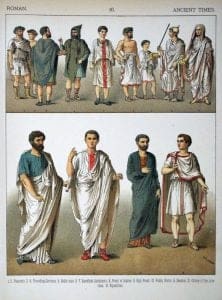
Through the course of Roman history, from the early years of ancient Rome in 753 B.C.E. to the fall of the Roman Empire in 476 C.E., there were two garments that were essential to the male wardrobe: the tunica and the toga. Adapted from the Greek chiton, the tunica, a type of shirt, was the simplest of garments. It was made from two rectangular pieces of fabric, one set on top of the other. It was sewn together at the sides and the top, with holes left for the head and the arms. Tunica’s could also have sleeves, ranging from very short in the early republic to full length later in the empire.
Only Romans were allowed to wear Toga (not the slaves, and not the free men, who were slaves before)
Social Classes and Costumes
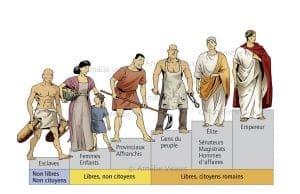
Tunics –
two pieces of woollen fabric sewn together at the sides and shoulders, with openings for your arms and head – were the most common clothes in Rome. Some Romans also wore togas – a kind of woollen shawl – to show how wealthy they were.

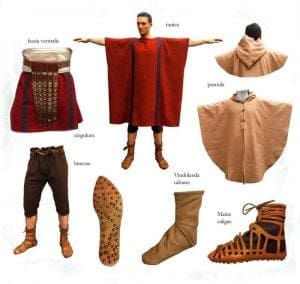
1st century AD roman tunic Clothing antiquity & prehistory – celticwebmerchant
Soldier Costume
The Romans used armor and weapons.
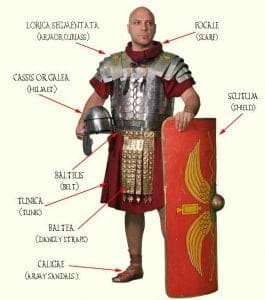
For their heads, they would use a helmet, called a Cassis. Their armor was called Lorica Segmenta. They also had on sandals and a red battle cloak. Their main weapons consisted of a sword called the Gladius and a throwing spear called the Pilium. They also carried a shield called Scutum.
TOGA


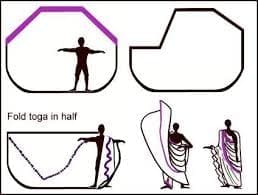

Women were wearing a STOLA, accompanied by a PALLA
Textile : Linen, wool, silk, cotton.
The garments were also embroidered with threads of gold
Fabric colors : White, unbleached, red, yellow, blue.
Purple: only members of the royal family were allowed to wear purple because it was very difficult to make the dye (from a sea snail)
Besides tunics, married citizen women wore a simple garment known as a stola ( stolae) which was associated with traditional Roman female virtues. Stolae typically comprised two rectangular segments of cloth joined at the side by fibulae and buttons in a manner allowing the garment to drape freely over the front of the wearer.
Over the stola, women often wore the palla, a sort of rectangular shawl up to 11 feet long, and five wide. It could be worn as a coat, or draped over the left shoulder, under the right arm, and then over the left arm. No respectable woman went bareheaded in public, so the palla could also serve as a hooded cloak.

Footwear
Romans used a wide variety of practical and decorative footwear, all of it flat soled (without heels).
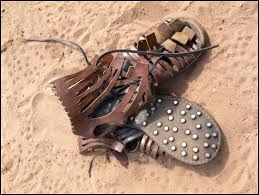
Outdoor shoes were often hobnailed for grip and durability. a usually hobnailed, thick-soled walking shoe (calcea):
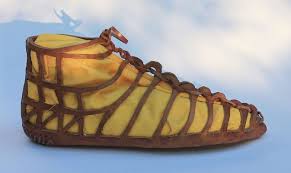
The most common types of footwear were a one-piece shoe (carbatina), sometimes with semi-openwork uppers:

a usually thin-soled sandal (solea), secured with thongs:
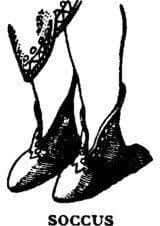
a laced, soft half-shoe (soccus):
From sandals and slippers to hobnailed military boots, Rome had it all. Roman shoes were typically made of leather but were also made of wood materials. There were several types of shoes that everyday Romans could wear.
There was the cabatina which according to Oracle Think Quest, was a sandal made from one piece of leather with a soft sole and secured with a lace. It was one of the simper shoes worn by off-duty soldiers.
There was also the soccus. This was one of the most basic forms of Roman shoe. This shoe was constructed using one piece of leather that gets sewn up along the heel and runs to the toe. It had a sole with no hobnails. It was basically a slipper mainly worn by Roman women and children only inside the home.
A calceus was a soft, leather, hobnailed shoe fastened using laces.It was considered the perfect cross between a sandal and a shoe. Worn with the toga, this shoe was the typical outdoor shoe of a Roman.
And finally, a solea was a simple sandal with a thin leather band between the toes and a hobnailed sole. This type of shoe was also referred to as a sandalia, or crepidae.
But there were also the military shoes. A soldier would wear a shoe known as the caliga.
This shoe was a particularly heavy sandal with a hobnailed sole and separate leather upper fastened by thin bands.
For most of the year, men and women alike wore sandals. The only difference between the two was that the women’s sandals were made of a softer leather.
In the winter shoes were often cork-soled because it was not as cold as other accessible materials.
When a Roman set out to dine with a friend, he wore his calcei and had his slave carry his soleae under his arm. At the entrance to the host’s house, the Roman took off his dirty shoes and put on his sandals until it was time to leave.
Rome woman Jewellery and hair Style
Jewelry
- Pins, fibulae, finger rings, snake designer, bracelet, necklaces
- Garnments and shoes were studded with emerald, pearls, opals, (precious stones) and aquamarine.
- They were wearing garlands, wreaths (couronne) made of flowers or gold leaves
- They were carrying fans, umbrellas, slippers, opne sandals, and boots were worn
Hairstyle
- Men were cleaned shaved with well grown short, stiff, curls on the forehead and back
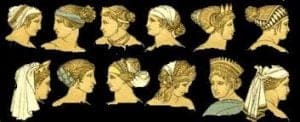
Women hairstyle varied from simple to elaborate knots.
Women were wearing elaborated make up, were painting their face, applied rouge, and tied their hair
Fabrics:
Most important was wool
Silk was coming from China
Silk from China was imported in significant quantities as early as the 3rd century BC. It was bought in its raw state by Roman traders at the Carthaginian ports of Tyre and Beirut, then woven and dyed. As Roman weaving techniques developed, silk yarn was used to make geometrically or freely figured damask, tabbies and tapestry. Some of these silk fabrics were extremely fine – around 50 threads or more per centimeter
Cotton was coming from India
Cotton from India was imported through the same Eastern Mediterranean ports that supplied Roman traders with silk and spices. Raw cotton was sometimes used for padding. Once its seeds were removed, cotton could be spun, then woven into a soft, lightweight fabric appropriate for summer use; cotton was more comfortable than wool, less costly than silk, and unlike linen, it could be brightly dyed
End of the Western Roman Empire
Roman Empire slitted into Western roman empire which fell in 476 and Eastern Roman Empire with Bysance and then Constantinople as capital
Roma fell in 476
Invaded by barbarian from the North: german, francs, longobardhi, normans etc.
Then the region of Italy was either under the Longobardhi or under the Eastern byzantine empire
Renaissance 1400 – 1600 AD

After middle age, the dark ages, there is a rebirth (meaning of the word renaissance), an awakening in the mind of people. It started in Italy and France and spread over all Europe. This period marks a change of the costumes. There were fashion personalities
Leonardo Da Vinci (Vinci, 1452- Amboise,1519)
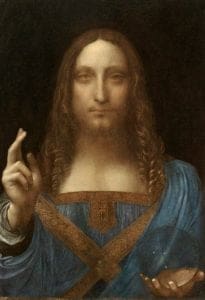
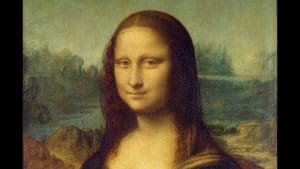
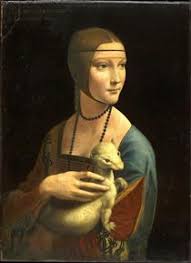
Michelangelo
(born March 6, 1475, Caprese, Republic of Florence [Italy]—died February 18, 1564, Rome, Papal States),
Italian Renaissance sculptor, painter, architect, and poet who exerted an unparalleled influence on the development of Western art.
Renaissance

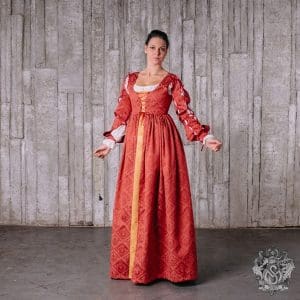
Italy was the first European country, which met the influence of Renaissance on the evolution of the costume.
This process had appeared in the end of the XV century due to wealth and independence of the biggest Italian towns – Venice, Genoa and Florence.
At the same time, so called Burgundian fashion was dominating on the other territory of Europe.( North of the Alpes)
Staged rethinking of the human person’s role, release of people’s consciousness from the incontestability of the church postulate and contagion of humanism ideas had a bearing on the costume evolution.
It found expression in the balanced division of dress and moderate emphasizing of particular body parts.

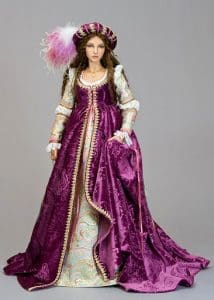
Fashion of Renaissance period declared absolutely new canons and prescribed new rules, calling to the most naturalness
Highlighting the main body parts, clothes were differ from too elongate silhouettes of the late Middle Ages.
All elements had become less fragmented and gained balanced entirety. Headwears were not extending forms any more, and horizontal fair lines became prevalent
Trend Setters
Of course, upper class was a trend-setter.
Costumes reflected social status and material wealth. But in contrast to the medieval costume with its strict regimentation about who can or can’t wear this or that piece of cloth,
Renaissance time clothing was open to everyone. It was aimed to show property status of owner, but not social one.
Probably, it was related to merchant class, which was developed in the early XV century.
Wives and daughters of the rich traders often were wearing more luxurious clothing than members of old noble families.
Fabric
Italy had strong trade links with East and was a center of silk industry. So, there was never lack of expensive and beautiful fabrics – patterned brocade, velvet, silk, which were often decorated with embroidery.
Living and intense colours gained popularity – wine-red, emeraldgreen, scarlet, purple and golden.
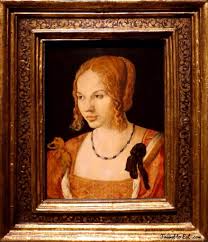
“Venetian Lady, Albrecht Durer, 1505 year. The Kunsthistorisches Museum (Museum of Art History), Vienna, Austria
Ideal Beauty

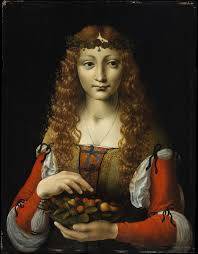

clothings were well proportioned with simple fair lines, because they considered to be an extension of the human body’ beauty, its “second skin”. Starting the early XV century, florentine fashionistas set the pace.
On many portraits of these times, you can see an ideal of women’s beauty – slender fair woman with long neck with exalted face and expansive forehead.
Italian Renaissance : Quattrocento (means the 1400s)
Dayers:
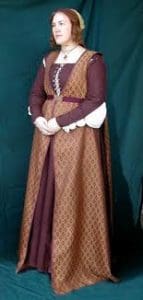
camicia (white long sleeves linen dress), Gamurra( high waist long dress with detachable sleeves), over it Giornea( slit sides and belted). Slowly the skirt will get fuller
Slash and Puff Fashion :

Both are painting of italian renaissance where we can observe this fashion of slash and puff. The outer fabric is slashed in order to puff out the under chemise. This fashion started in the 1400 and went on till the 1500.
Sleeves: Straight sleeves had being attached to the armhole with strings or lacing, so when needed, variously coloured sleeves could be used with one dress.
Puffy shape and expensive decoration made sleeves the most important adornment of dress.
Probably, crafters used all their imagination for sleeves’ accents, when creating women’ dresses.
Cinque Cento (1500s) in Italy and Spain were the Dominant Culture at that Time : The Silhouette is become bigger

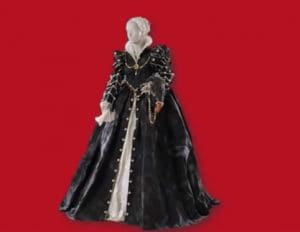
The world has double in size and so the fashion: Huge sleeves, big skirts, a lot of satin
Lets break the layers: Chemise- then there is a Bust( it flattens and stiffes the torso to hold the heavy fabric) – over that sleeveless gown with detachable sleeves,( Baragoni sleeves are the ones with rushes on the top), colletto, butt emphasis.
Hair and headdresses
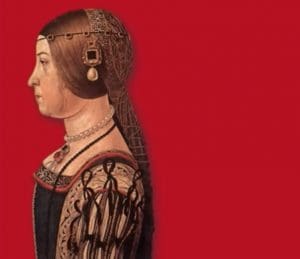
Let’s look at hair and headdresses in the Quattrocento.
Here is a wonderful profile image. This hairstyle is called “coazzoni”.
Men Attire:

Men: wear a doublet often padded with leg mutton sleeves, with over a giornea ( quilted shorter than the one of women) , over it Coppea ( cape) Quattrocento Color palette: redgold- earth tones colors- blue
Early Renaissance men’s costume was highly competitive to
women’s dresses with pomp and pageantry. Tight-fitted doublets similar to the burgundian models existed, but did not have extreme shapes
So, clothes were much more comfortable
Shoes
But what were people wearing on their feet? Well, men were wearing little booties, but ladies were wearing high heels. These are called “chopines” and they’re basically platform heel wedges.
A lot of people think that high heels started in the reign of Marie Antoinette or something. But they didn’t. In the West, they started in the 1400s, although people had been wearing high heels in Asia for far longer.
Long Cloaks:
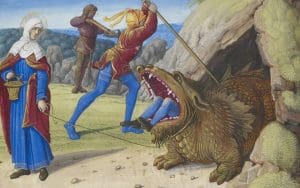
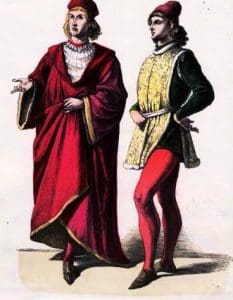
Long loose cloaks with wide sleeves were usually worn by elder people, judges or scholars. Nowadays, magisters of universities wear similar models of cloaks during solemn ceremonies
Undershirt:

White linen undershirt was long enough to be tucked into the pants. Sleeves of shirt were so puffed, so they could be passed through the cuts to create plenty of puffs. Neck hole was ruffled and had strings. Often, shirt was decorated with ribbons or laces.
Doublet:

Over the shirt, men were wearing doublet, which were fastened with buttons or closing from the front. Length of doublet could be very short (to the waist level), or could cover the hips.
As a rule, sleeves were fixed to the sleeve cap with little fasteners or wide ribbons.
As a result, a man had freedom of movements and variety of clothing, as he could attach different sleeves to the one doublet
Hoses:
On the leg, italian chevaliers were wearing tight pants – hosessewn of the resilient fabrics, which did not hinder the movements. In the XV century, some innovation in men’s fashion has appeared. There was a codpiece, which combined two parts of pants and was attached with lacing or small buttons.
For long time, men were wearing multi-coloured hoses, for example, one pant leg was sewn of unicolour fabric, and the second one – of strips of different colours.
Men began to wear short puffed hautde-chausses over the fitting stocking only in the end of the XV century.
Coats:

Coats were widespread in italian fashion at the time.
They could be fastened or tied to the upper part of doublet. Length varied: sometimes, coats were middle-thigh length, and sometimes they were dragging on the ground.
Up to early XVI century, venetian fashionists were wearing coats with pelerine type collars
Spanish court fashion
The Spanish court had a very different flavor. It was still big but less voluminous and much more dramatic. Let’s take a quick look at Spanish court fashion.

Headwears :
Men’s headwears were notable for variety of cuts, shapes, fabrics and decoration, such as bright long feathers, laces and gems.
Some dandies were even wearing two hats at the same time: one on the head, and the second one was laced to the shoulders.
Hanging pursues and gloves were the most popular accessories.
Jewellery
Italian men loved different adornments, made by famous jewellers.
Both, men and women were wearing precious signet rings (often over the gloves) and thick golden chains.
Men also attached small anlace in ornate sneath.
Conclusion Renaissance
Balance in proportions,
bright colour-scheme and
wanting to accent specific individuality of costume owner were typical for gowns of the Renaissance epoch.
In such a manner, in consequence of the revival of ancient world’ humanist ideals, general concept about the beauty has been changed.
17th Century Onwards
In the 17th century, Italian fashion fell into a decline, while Spain, England, and France led the industry.
In Europe, French fashion was most popular.
The fashion industry remained active in Italy, especially in Rome, Milan, and Florence.
In the mid-19th century, cheaper silk was imported to Milan from Asia because the phylloxera pest infestation damaged silk and wine produced in Italy.
After industrialization, metal, mechanical, and furniture manufacturing replaced textile production.
Some of the first modern Italian fashion designers, such as Bulgari, Prada, Gucci, and Ferragamo, were founded in the late 19th and early 20th centuries. In the 1950s and 1960s, Italian fashion regained popularity worldwide.
Traditional Costumes Worn Today
On every day bases nobody wears traditional costumes anymore
But it is still worn in some regions during festival
The costume vary very much from region to region
Carnival also are important and different in each region, people wear mask and costumes of important characters of the local culture
Carnival Characters : Pulcinella
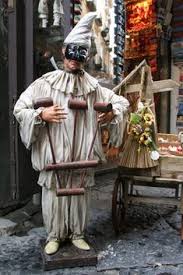
From south Italy Napoli
Linked with Commedia dell’Arte characters
Character which mocks rich and aristocratie
Pulcinella represents Napoli- and is Impertinent, likes to eat, speaks a lot
Arlequino

From Bergamo, north Italy on left
Irreverent character, a little bit of a cheater, he is a servant who mocks his boss
Farinella from South, Bari in Puglie
Carnival Venezia and Cento


Traditional Costumes
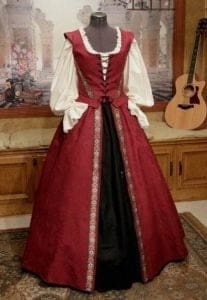
Traditional costumes have their origin in pré modern time. Often they are linked with a remote past which is not fully defined
Traditional costumes develop in all Europe from 1800s, in order to have a national identity.
Therefore, the costume is not anymore linked with social class but it is linked with national identity
Once upon a time the traditional costume was worn every day, but it was more decorated during festivals
Sardegna Island: Black and Red Dress
National Dress of Italy
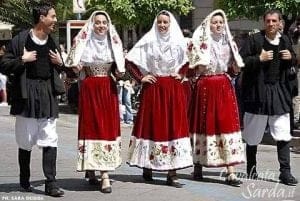
Between the 19th and 20th centuries in the island of Sardinia there were as many as 400 different traditional costumes. Nearly every village had its own typical outfit, which was worn with pride as this was part of people’s local heritage and also reflected people’s place in society. Although individual costumes varied greatly, they had certain features in common: women wore a veil, a shawl, long pleated skirts and embroidered blouses, whilst men wore a knit wool cap with a long tail, a close-fitted jacket and loose white trousers. Traditional Sardinian garb is extremely colourful and features elaborate embroidery. Embroidery is still a thriving craft that is evident in the beautiful traditional shawls boasting different flower patterns.
These days, Sardinian traditional clothes are worn during folk festivals and major religious holidays but you can admire them all year round in the many ethnographic museums.
Started in the 16th Century
Mainly black and white or red and white. The head is covered by a white clothe
Sardegna Men Costume

On the head : BERRITTA, long 40 CM
Shirt called CAMIGIA
Either a kind of waistcoat called CANSCIU, often black or red
Either a jacket black or red made often of velvet
Very wide white trousers called mutandoni
Short pleated skirt over the trousers, in black
I Ghetti, kind of getre, black, from ankles to under the knees
Black shoes
Alto Adige – Tyrol
Each village has his own Trach.
The tracht is worn till today for many occasions
It is the symbol of the love for their region
South Tyrol
Men and Women Costumes
Men wear a white shirt in linen, a waistcoat with silver buttons and a red handkerchief or blue in the pocket, a black scarf, suspenders called Heber, leather short trousersblack, white socks and black shoes
The belt is one of the interesting thing of this costume. It is hand decorated and embroidered with peacock feather.


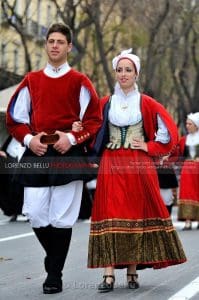

Women wear dresses, with long skirt of at least 4 or 5 meters fabric, generally green or black.
White embroidered shirt
Often Red socks
Tablier or Apron:

VAL D’aosta North Italy Costume Di Gressoney

The Women Of Italy Wear colorful Embroidered skirts and bodices over light-weight chemises or blouses.
The Were elaborate hats decorated with flowers or fruit.
Men’s of Italy Traditional clothing tends to be simpler but doesn’t lack attention to detail with embroidery and metal buttons and Pins. These costumes evolved from simpler peasant dress in the Middle Ages.
References :
Study By Mrs. Diana Linda
https://www.natgeokids.com/uk/discover/geography/countries/facts-about-italy/
https://matthanna123.wordpress.com/equipmentoftheromans/
https://unleashingthelesserknown.wordpress.com/page/2/
https://sites.google.com/site/fashionintheancientworld/home/the-fine-footwear-of-ancient-rome
http://www.renaissance-spell.com/Renaissance-Clothing/
https://steel-mastery.com/italian-costumes-of-renaissance-period-xv-century
https://sites.google.com/site/textileshistoricalper/ancient-times

